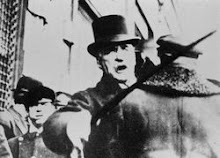One of the biggest problems with our current financial system is the fact that lower interest rates -- or the reasonable expectation of falling future interest rates -- encourages overinvestment. This inevitably leads to speculation and a subsequent asset price bubble. As Kindleberger states in his timeless "Manias, Panics, and Crashes" over trading through speculation will be followed by a "CONVULSION." Oftentimes this is some outside news factor that suddenly makes the boom model untenable.
In the case of the current crisis, the exogenous news factor was the pricking of another asset price bubble: the housing market. When ripples from the housing bust hit the banks of the world, it created a chain reaction. While our banks lost lots of money on their crappy mortgage exposure, their losses were dwarfed in magnitude by those experienced in the subsequent world stock market carnage. Some 30 TRILLION DOLLARS of wealth evaporated in 2008. But how much was made on the way up? Considering the current boom can be traced to the 1970's 30 trillion is just a drop in the bucket.
One lesson must be leaned from the thousands of years humans have used money and trade to lubricate their lives. Markets will have booms. Booms will lead to busts. But when the rate of interest is near zero percent: the urge to lever up will become too great.
Somewhere, sometime in the future, some trader at some bank will figure out that he can borrow from the fed for zero percent and lend for two percent. He will make a huge bonus and all his trader friends will do the same type of trade. The next year many traders will leave this bank and go to other banks and hedge funds. There they will tell tales of their trade, and they will borrow money at zero percent and lend money at two percent. Except when EVERYBODY does this, we will have another credit bubble.
The money lent out at 2% won't just sit in a drawer some where. It will be invested in some asset. If the speed at which money is being lent creates more money that needs to be invested than the supply of existing assets, prices will rise. But we can't use classical economics here. This is because while the supply of assets will certainly increase from bankers hocking IPO's and new bond issues, financial assets are not normal goods.
When a normal good or service rises in price, people consume less of it. When the price of a stock goes up, more people want to buy it. They see others making a killing and want a piece of their own. Likewise, when prices go down people sell more: they don't want to lose even more money. This means that credit bubbles become unstoppable reinforcing "virtuous cycles." These, of course, are followed by horrifying unrelenting market declines (vicious cycles).
Prices will stabilize. Money will be relent at too low interest rates. Money will be borrowed by firms and investors which will push up asset prices. More money will be lent. Some will go to increased demand for borrowed funds by speculators. They want to take advantage of rising prices. More money will be lent...
Are Prediction Markets Really A Threat To DraftKings?
27 minutes ago





1 comment:
Excellant!! Simply acknowledging what we all know, but consistently deny. Everything cycles. People do not seem to appreciate the highs to the degree that they cry about the lows. Did the $50,000 per year wage earner ever plan on paying for the #300,000 house?
Post a Comment